Financial Resource Decisions: A Coffee Shop Business Analysis
VerifiedAdded on 2020/02/05
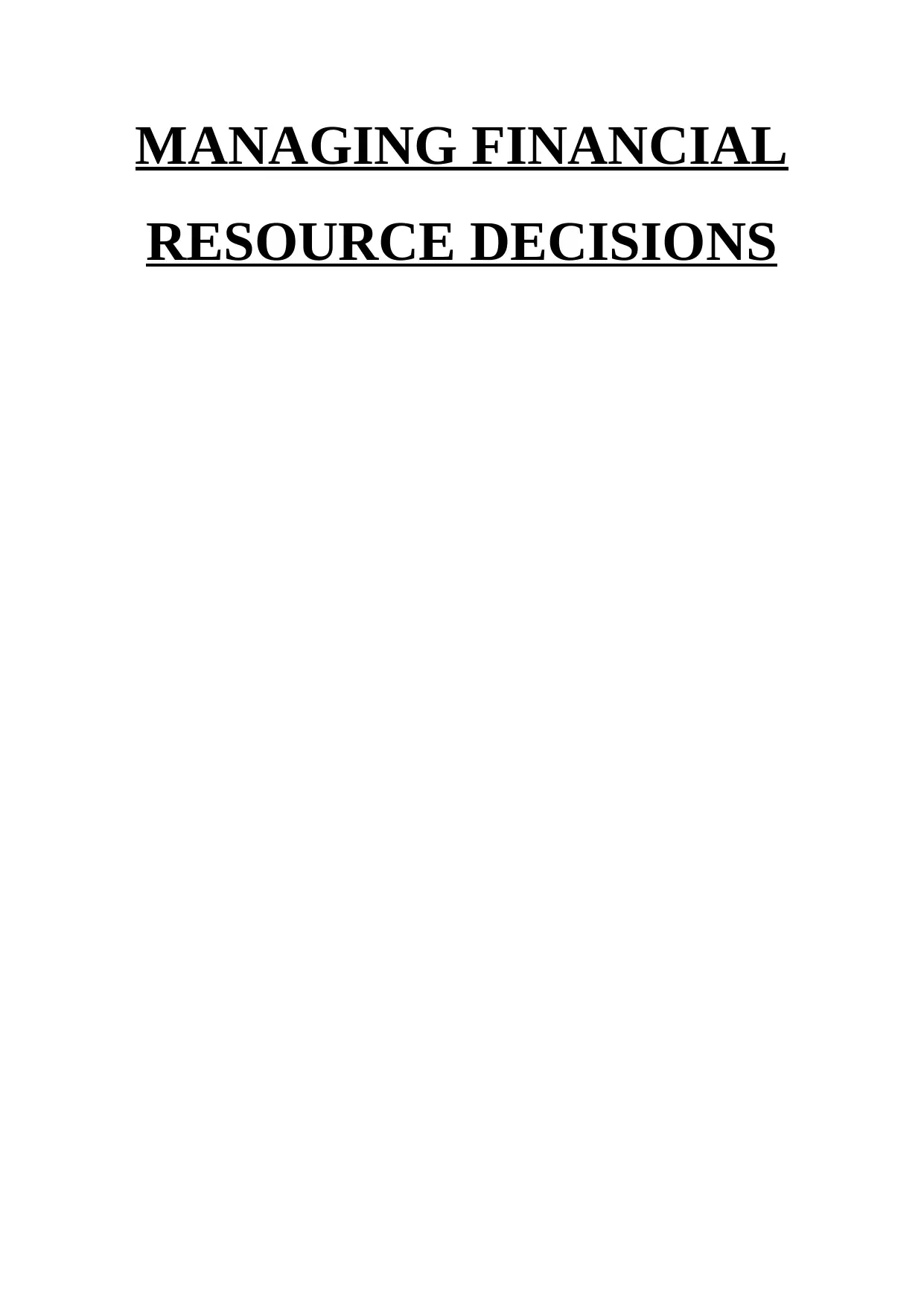
RESOURCE DECISIONS
Paraphrase This Document
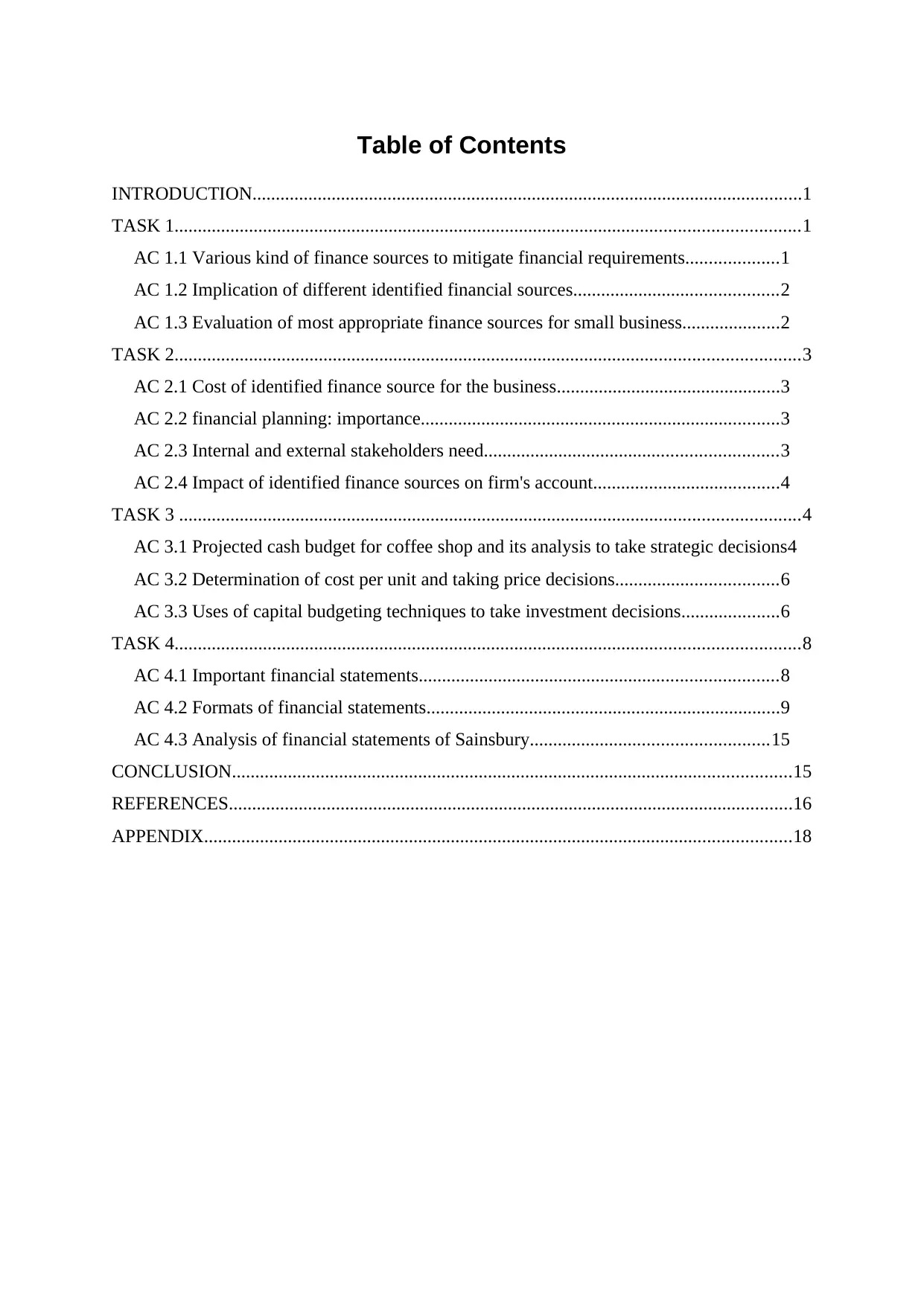
INTRODUCTION......................................................................................................................1
TASK 1......................................................................................................................................1
AC 1.1 Various kind of finance sources to mitigate financial requirements....................1
AC 1.2 Implication of different identified financial sources............................................2
AC 1.3 Evaluation of most appropriate finance sources for small business.....................2
TASK 2......................................................................................................................................3
AC 2.1 Cost of identified finance source for the business................................................3
AC 2.2 financial planning: importance.............................................................................3
AC 2.3 Internal and external stakeholders need...............................................................3
AC 2.4 Impact of identified finance sources on firm's account........................................4
TASK 3 .....................................................................................................................................4
AC 3.1 Projected cash budget for coffee shop and its analysis to take strategic decisions4
AC 3.2 Determination of cost per unit and taking price decisions...................................6
AC 3.3 Uses of capital budgeting techniques to take investment decisions.....................6
TASK 4......................................................................................................................................8
AC 4.1 Important financial statements.............................................................................8
AC 4.2 Formats of financial statements............................................................................9
AC 4.3 Analysis of financial statements of Sainsbury...................................................15
CONCLUSION........................................................................................................................15
REFERENCES.........................................................................................................................16
APPENDIX..............................................................................................................................18

Table 1: Projected cash budget for the period of 6 months .......................................................4
Table 2: Computation of cost per unit........................................................................................6
Table 3: Computation of PP and ARR.......................................................................................7
Table 4: Computation of NPV and IRR.....................................................................................7
Table 5: Ratio analysis of Sainsbury for 2015 and 2014.........................................................18
Illustration Index
Illustration 1: P&L account for sole proprietor........................................................................10
Illustration 2: Balance sheet of sole trader...............................................................................11
Illustration 3: Profit and loss account of partnership...............................................................11
Illustration 4: Balance sheet of partnership..............................................................................12
Illustration 5: Sainsbury's profitability statement.....................................................................13
Illustration 6: Sainsbury's balance sheet ..................................................................................14
⊘ This is a preview!⊘
Do you want full access?
Subscribe today to unlock all pages.

Trusted by 1+ million students worldwide
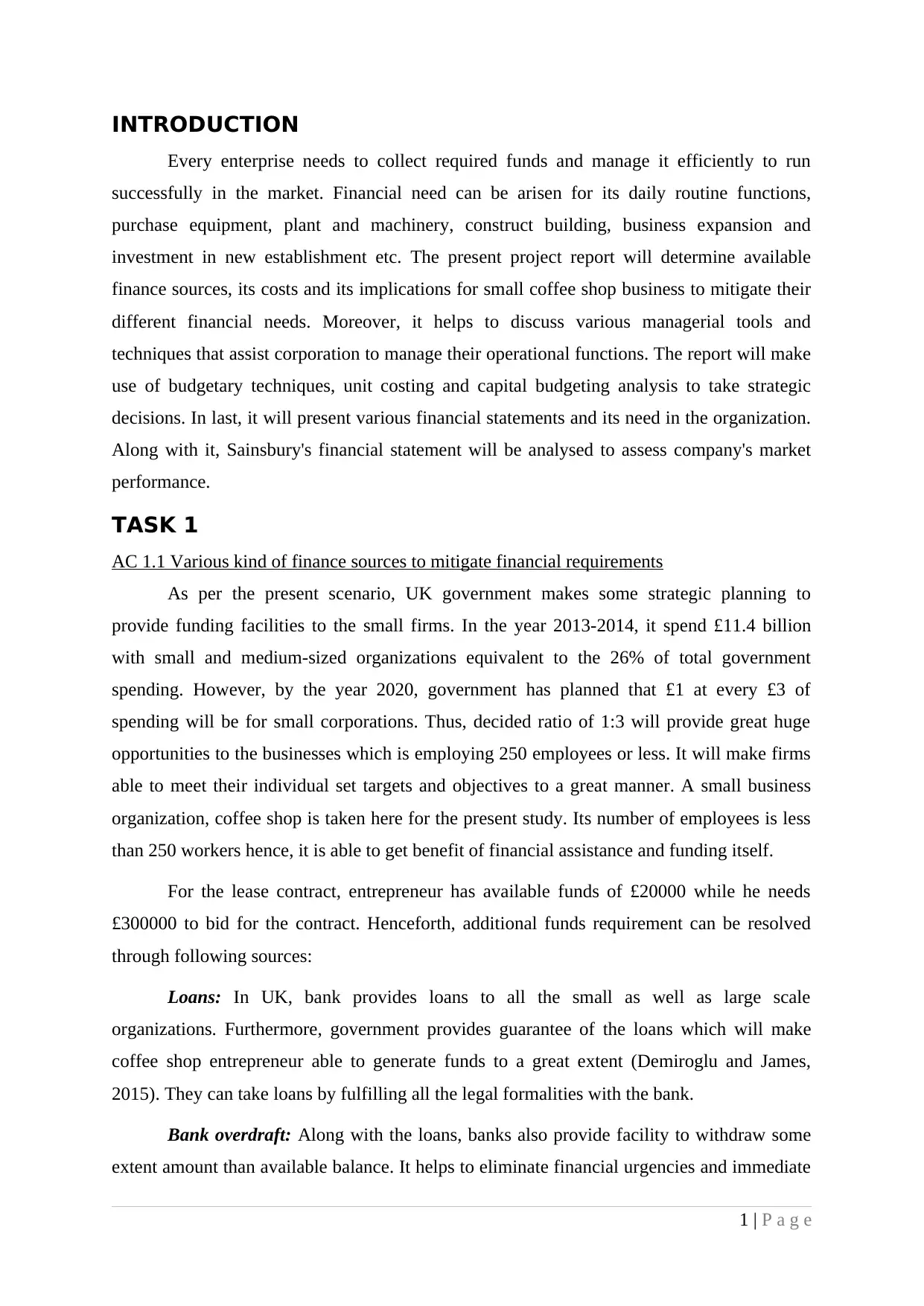
Every enterprise needs to collect required funds and manage it efficiently to run
successfully in the market. Financial need can be arisen for its daily routine functions,
purchase equipment, plant and machinery, construct building, business expansion and
investment in new establishment etc. The present project report will determine available
finance sources, its costs and its implications for small coffee shop business to mitigate their
different financial needs. Moreover, it helps to discuss various managerial tools and
techniques that assist corporation to manage their operational functions. The report will make
use of budgetary techniques, unit costing and capital budgeting analysis to take strategic
decisions. In last, it will present various financial statements and its need in the organization.
Along with it, Sainsbury's financial statement will be analysed to assess company's market
performance.
TASK 1
AC 1.1 Various kind of finance sources to mitigate financial requirements
As per the present scenario, UK government makes some strategic planning to
provide funding facilities to the small firms. In the year 2013-2014, it spend £11.4 billion
with small and medium-sized organizations equivalent to the 26% of total government
spending. However, by the year 2020, government has planned that £1 at every £3 of
spending will be for small corporations. Thus, decided ratio of 1:3 will provide great huge
opportunities to the businesses which is employing 250 employees or less. It will make firms
able to meet their individual set targets and objectives to a great manner. A small business
organization, coffee shop is taken here for the present study. Its number of employees is less
than 250 workers hence, it is able to get benefit of financial assistance and funding itself.
For the lease contract, entrepreneur has available funds of £20000 while he needs
£300000 to bid for the contract. Henceforth, additional funds requirement can be resolved
through following sources:
Loans: In UK, bank provides loans to all the small as well as large scale
organizations. Furthermore, government provides guarantee of the loans which will make
coffee shop entrepreneur able to generate funds to a great extent (Demiroglu and James,
2015). They can take loans by fulfilling all the legal formalities with the bank.
Bank overdraft: Along with the loans, banks also provide facility to withdraw some
extent amount than available balance. It helps to eliminate financial urgencies and immediate
1 | P a g e
Paraphrase This Document

source also.
Cash squeezing operations: Firm can negotiate their payments and receive earlier
from their debtors so that they can avail greater funds availability and remove operational
difficulties.
Lease: Coffee shop can take building on the basis of lease financing and mitigate the
need of building acquisition (Wong and Joshi, 2015). The reason behind this is that lease is
the right of using assets without having its ownership at some hiring charges.
AC 1.2 Implication of different identified financial sources
Every source has some kind of legal and operational implications on the coffee shop.
Generating funds from loans will impose obligations to pay timely interest plus instalment.
Further, there is some legal formalities which must be comply with the banks for gathering
funds. For instance, collateral security and guarantee may be demanded by the banks for
securing loans (Allen and Paligorova, 2015). In case of any default in payments, banks have
legal right to collect their funds through dispose of the security. On contrary, its advantage is
that it does not transfer the ownership and interest is considered as deductible expenses for
tax computation. Hence, it reduces tax liabilities and enhances profits. Further, bank charges
interest rate on overdrafts which is comparatively higher than loan interest rate. Moreover, it
cannot be used for long-term financial requirements. However, cash squeezing operation is
not a permanent source of finance. It can be successful if suppliers are ready to provide long-
term credit to the coffee shop. Good liquidity position and profitability make firm able to
extent their credit period. In addition, lease financing imposes obligations to pay periodical
rental charges (Gillispie and Hawkins, 2015). Otherwise, lessor has legal right to get back
their assets again.
AC 1.3 Evaluation of most appropriate finance sources for small business
Through analysing the implications of various identified sources, it can be concluded
that bank loans are comparatively an easier source of finance for establishing the coffee shop.
The reason behind this is that it mitigates financial need for different time duration.
Furthermore, government guarantee and lending schemes increase unsecured loans on the
behalf of government guarantee (SME Access to finance Schemes, n.d.). Thus, it assists coffee
shop to collect adequate funds without providing any security. Further, loan guarantee
schemes, funding for lending schemes and start up loans help to collect funds at cheaper
2 | P a g e
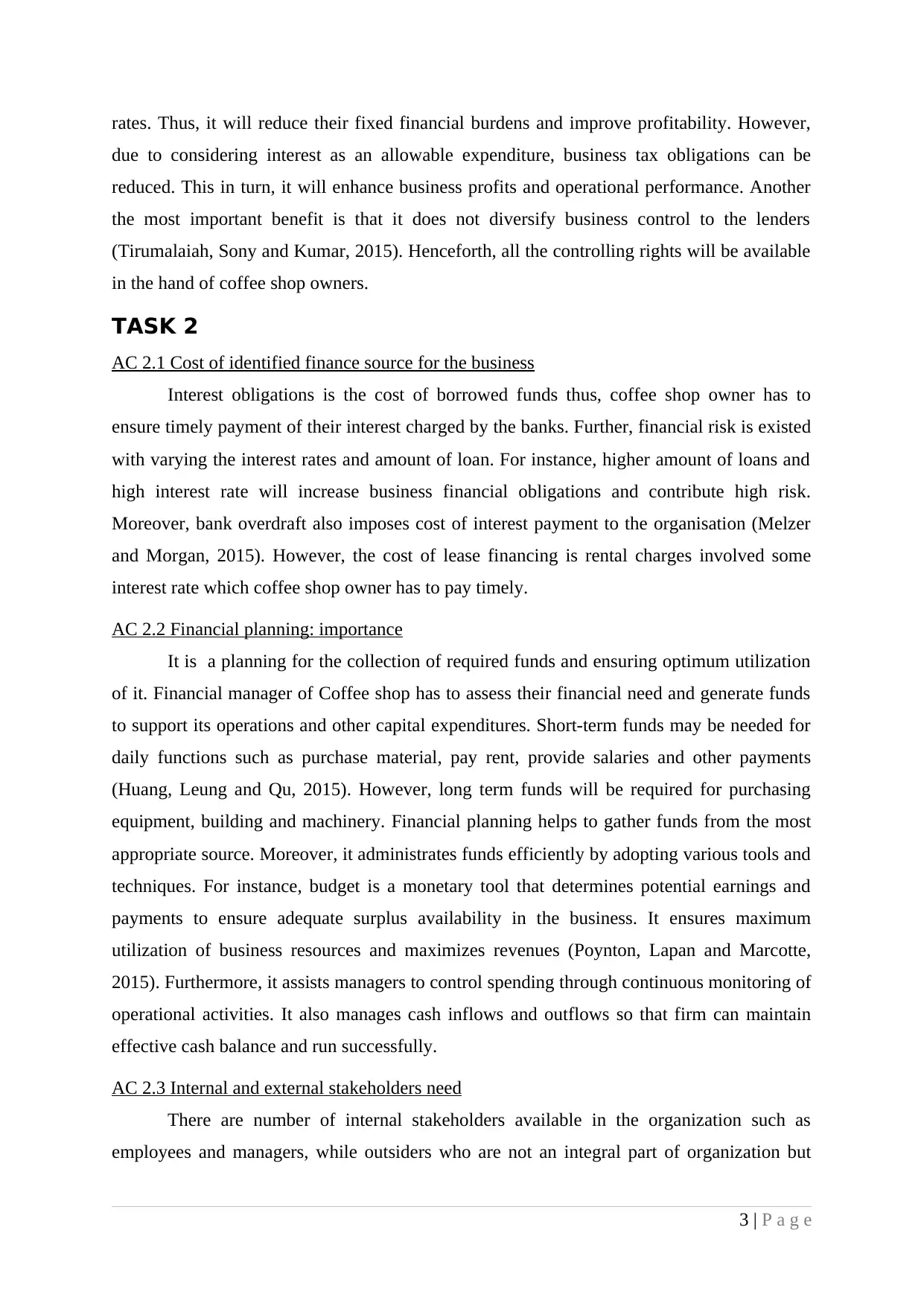
due to considering interest as an allowable expenditure, business tax obligations can be
reduced. This in turn, it will enhance business profits and operational performance. Another
the most important benefit is that it does not diversify business control to the lenders
(Tirumalaiah, Sony and Kumar, 2015). Henceforth, all the controlling rights will be available
in the hand of coffee shop owners.
TASK 2
AC 2.1 Cost of identified finance source for the business
Interest obligations is the cost of borrowed funds thus, coffee shop owner has to
ensure timely payment of their interest charged by the banks. Further, financial risk is existed
with varying the interest rates and amount of loan. For instance, higher amount of loans and
high interest rate will increase business financial obligations and contribute high risk.
Moreover, bank overdraft also imposes cost of interest payment to the organisation (Melzer
and Morgan, 2015). However, the cost of lease financing is rental charges involved some
interest rate which coffee shop owner has to pay timely.
AC 2.2 Financial planning: importance
It is a planning for the collection of required funds and ensuring optimum utilization
of it. Financial manager of Coffee shop has to assess their financial need and generate funds
to support its operations and other capital expenditures. Short-term funds may be needed for
daily functions such as purchase material, pay rent, provide salaries and other payments
(Huang, Leung and Qu, 2015). However, long term funds will be required for purchasing
equipment, building and machinery. Financial planning helps to gather funds from the most
appropriate source. Moreover, it administrates funds efficiently by adopting various tools and
techniques. For instance, budget is a monetary tool that determines potential earnings and
payments to ensure adequate surplus availability in the business. It ensures maximum
utilization of business resources and maximizes revenues (Poynton, Lapan and Marcotte,
2015). Furthermore, it assists managers to control spending through continuous monitoring of
operational activities. It also manages cash inflows and outflows so that firm can maintain
effective cash balance and run successfully.
AC 2.3 Internal and external stakeholders need
There are number of internal stakeholders available in the organization such as
employees and managers, while outsiders who are not an integral part of organization but
3 | P a g e
⊘ This is a preview!⊘
Do you want full access?
Subscribe today to unlock all pages.

Trusted by 1+ million students worldwide
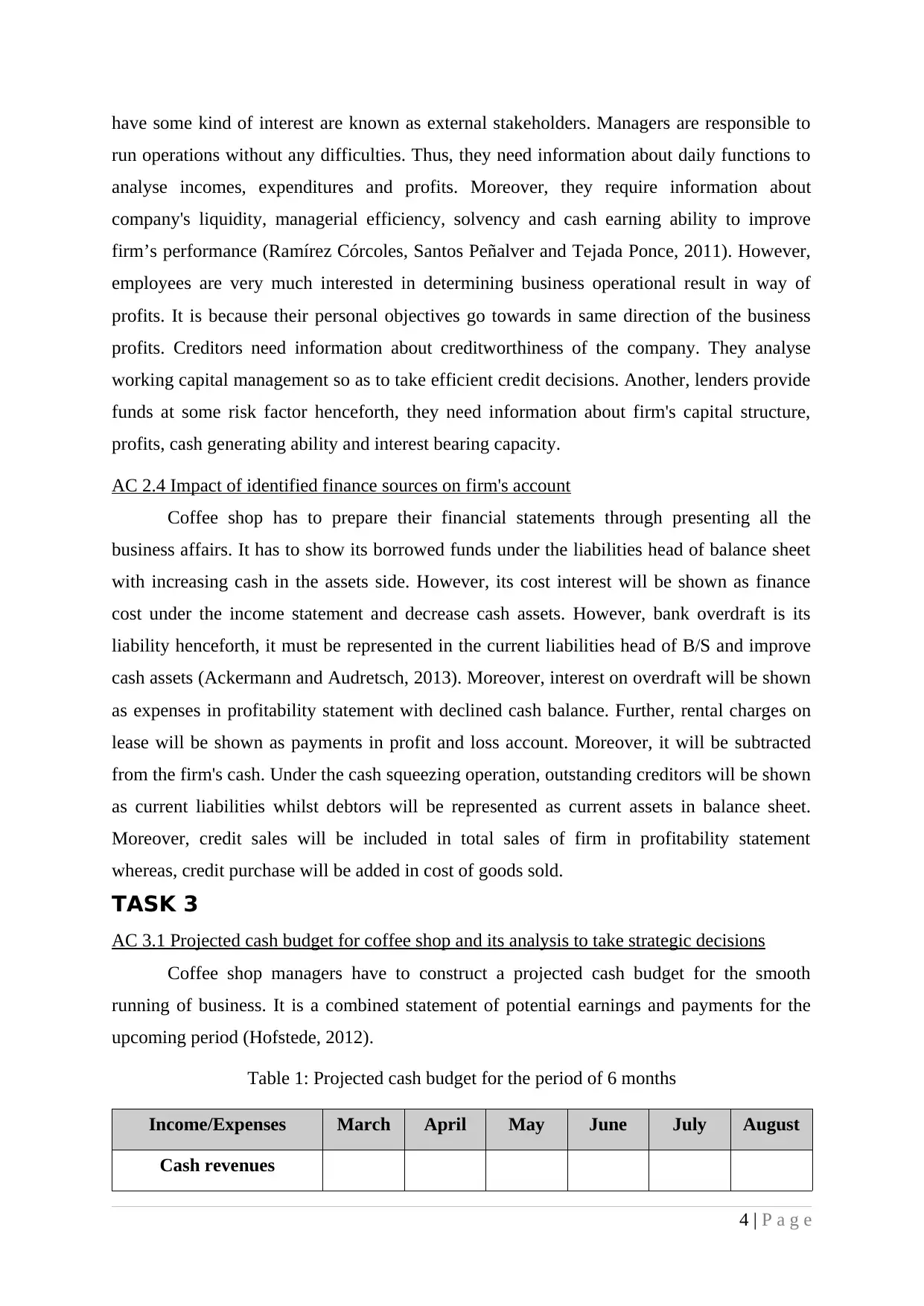
run operations without any difficulties. Thus, they need information about daily functions to
analyse incomes, expenditures and profits. Moreover, they require information about
company's liquidity, managerial efficiency, solvency and cash earning ability to improve
firm’s performance (Ramírez Córcoles, Santos Peñalver and Tejada Ponce, 2011). However,
employees are very much interested in determining business operational result in way of
profits. It is because their personal objectives go towards in same direction of the business
profits. Creditors need information about creditworthiness of the company. They analyse
working capital management so as to take efficient credit decisions. Another, lenders provide
funds at some risk factor henceforth, they need information about firm's capital structure,
profits, cash generating ability and interest bearing capacity.
AC 2.4 Impact of identified finance sources on firm's account
Coffee shop has to prepare their financial statements through presenting all the
business affairs. It has to show its borrowed funds under the liabilities head of balance sheet
with increasing cash in the assets side. However, its cost interest will be shown as finance
cost under the income statement and decrease cash assets. However, bank overdraft is its
liability henceforth, it must be represented in the current liabilities head of B/S and improve
cash assets (Ackermann and Audretsch, 2013). Moreover, interest on overdraft will be shown
as expenses in profitability statement with declined cash balance. Further, rental charges on
lease will be shown as payments in profit and loss account. Moreover, it will be subtracted
from the firm's cash. Under the cash squeezing operation, outstanding creditors will be shown
as current liabilities whilst debtors will be represented as current assets in balance sheet.
Moreover, credit sales will be included in total sales of firm in profitability statement
whereas, credit purchase will be added in cost of goods sold.
TASK 3
AC 3.1 Projected cash budget for coffee shop and its analysis to take strategic decisions
Coffee shop managers have to construct a projected cash budget for the smooth
running of business. It is a combined statement of potential earnings and payments for the
upcoming period (Hofstede, 2012).
Table 1: Projected cash budget for the period of 6 months
Income/Expenses March April May June July August
Cash revenues
4 | P a g e
Paraphrase This Document
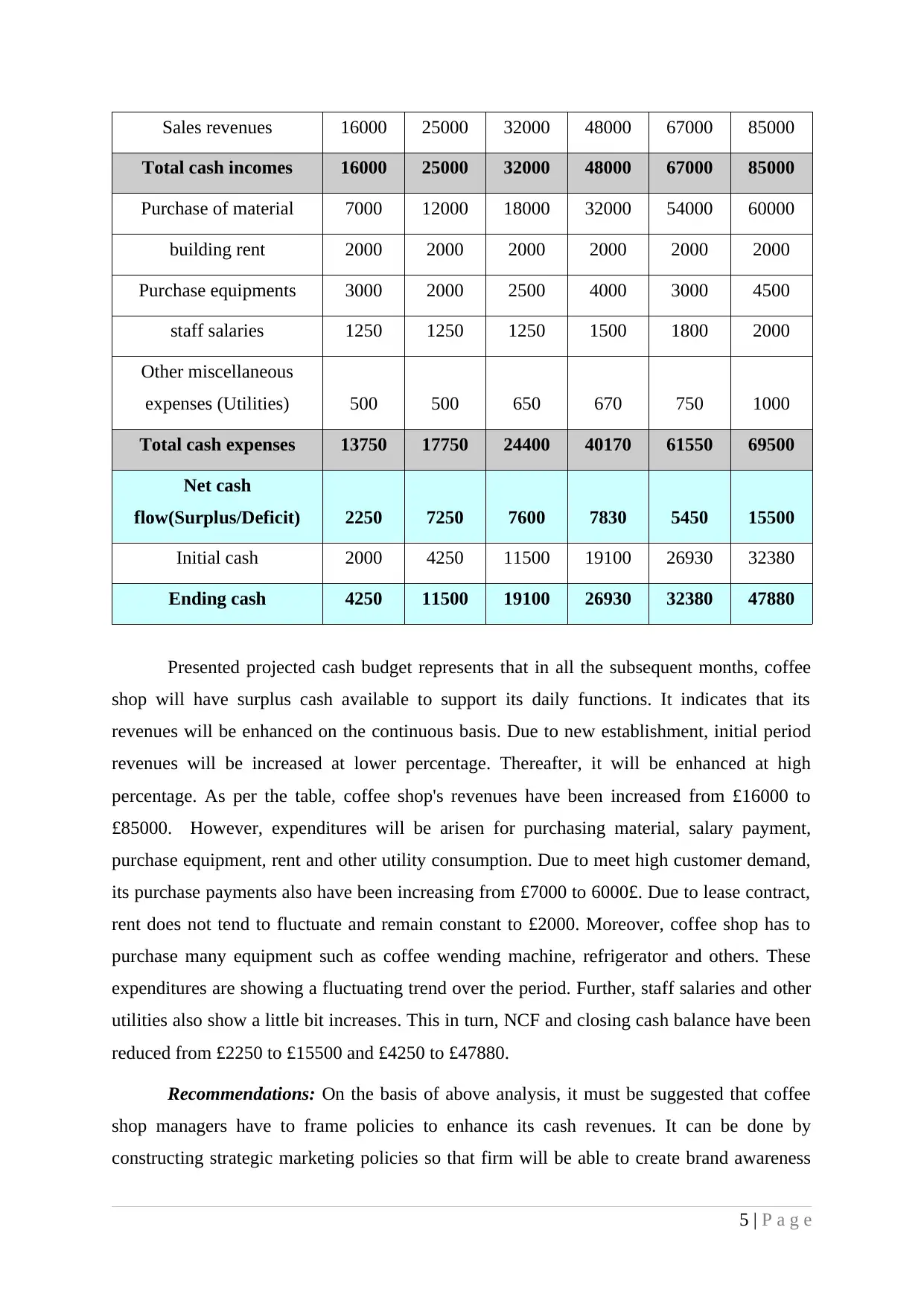
Total cash incomes 16000 25000 32000 48000 67000 85000
Purchase of material 7000 12000 18000 32000 54000 60000
building rent 2000 2000 2000 2000 2000 2000
Purchase equipments 3000 2000 2500 4000 3000 4500
staff salaries 1250 1250 1250 1500 1800 2000
Other miscellaneous
expenses (Utilities) 500 500 650 670 750 1000
Total cash expenses 13750 17750 24400 40170 61550 69500
Net cash
flow(Surplus/Deficit) 2250 7250 7600 7830 5450 15500
Initial cash 2000 4250 11500 19100 26930 32380
Ending cash 4250 11500 19100 26930 32380 47880
Presented projected cash budget represents that in all the subsequent months, coffee
shop will have surplus cash available to support its daily functions. It indicates that its
revenues will be enhanced on the continuous basis. Due to new establishment, initial period
revenues will be increased at lower percentage. Thereafter, it will be enhanced at high
percentage. As per the table, coffee shop's revenues have been increased from £16000 to
£85000. However, expenditures will be arisen for purchasing material, salary payment,
purchase equipment, rent and other utility consumption. Due to meet high customer demand,
its purchase payments also have been increasing from £7000 to 6000£. Due to lease contract,
rent does not tend to fluctuate and remain constant to £2000. Moreover, coffee shop has to
purchase many equipment such as coffee wending machine, refrigerator and others. These
expenditures are showing a fluctuating trend over the period. Further, staff salaries and other
utilities also show a little bit increases. This in turn, NCF and closing cash balance have been
reduced from £2250 to £15500 and £4250 to £47880.
Recommendations: On the basis of above analysis, it must be suggested that coffee
shop managers have to frame policies to enhance its cash revenues. It can be done by
constructing strategic marketing policies so that firm will be able to create brand awareness
5 | P a g e
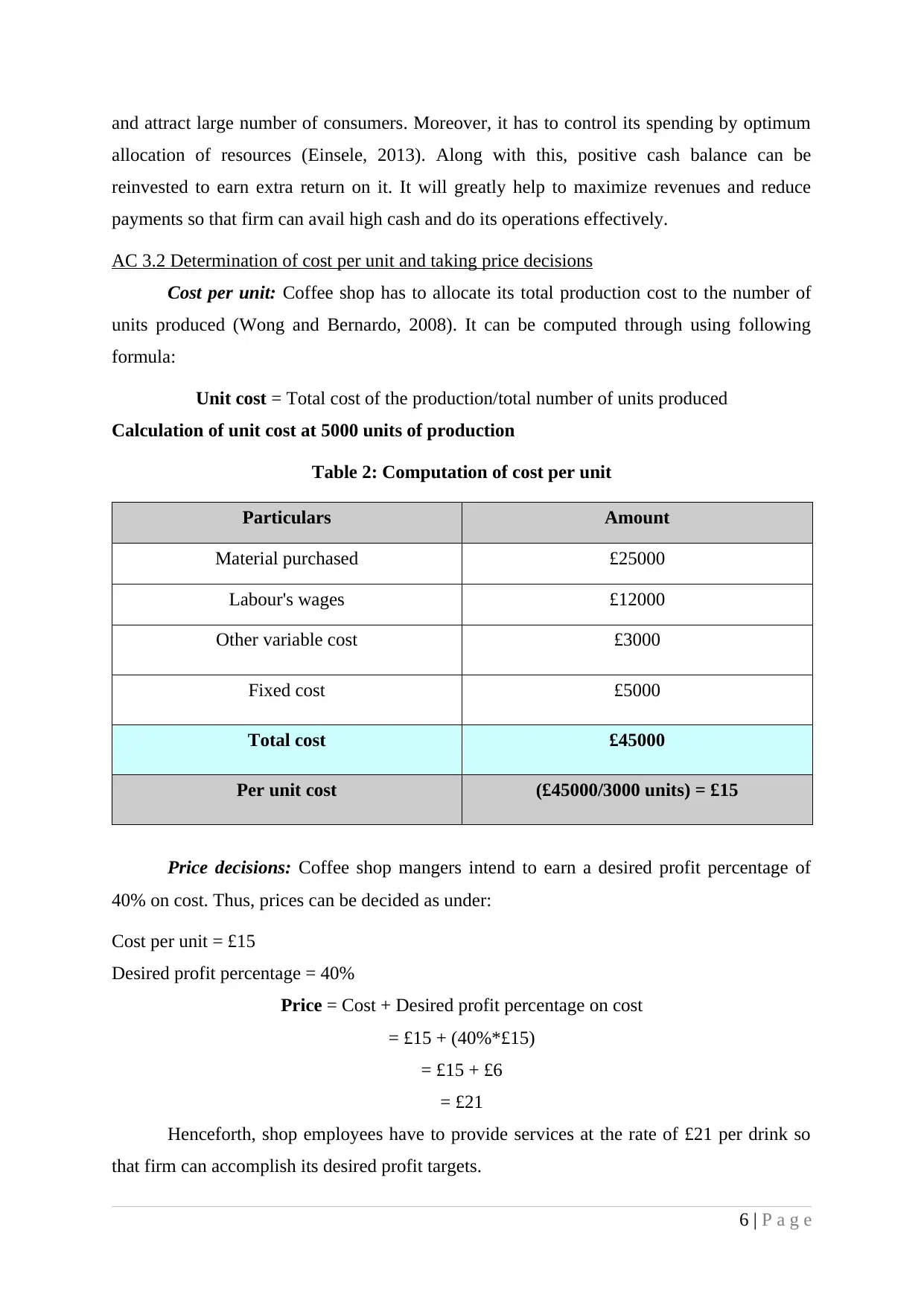
allocation of resources (Einsele, 2013). Along with this, positive cash balance can be
reinvested to earn extra return on it. It will greatly help to maximize revenues and reduce
payments so that firm can avail high cash and do its operations effectively.
AC 3.2 Determination of cost per unit and taking price decisions
Cost per unit: Coffee shop has to allocate its total production cost to the number of
units produced (Wong and Bernardo, 2008). It can be computed through using following
formula:
Unit cost = Total cost of the production/total number of units produced
Calculation of unit cost at 5000 units of production
Table 2: Computation of cost per unit
Particulars Amount
Material purchased £25000
Labour's wages £12000
Other variable cost £3000
Fixed cost £5000
Total cost £45000
Per unit cost (£45000/3000 units) = £15
Price decisions: Coffee shop mangers intend to earn a desired profit percentage of
40% on cost. Thus, prices can be decided as under:
Cost per unit = £15
Desired profit percentage = 40%
Price = Cost + Desired profit percentage on cost
= £15 + (40%*£15)
= £15 + £6
= £21
Henceforth, shop employees have to provide services at the rate of £21 per drink so
that firm can accomplish its desired profit targets.
6 | P a g e
⊘ This is a preview!⊘
Do you want full access?
Subscribe today to unlock all pages.

Trusted by 1+ million students worldwide
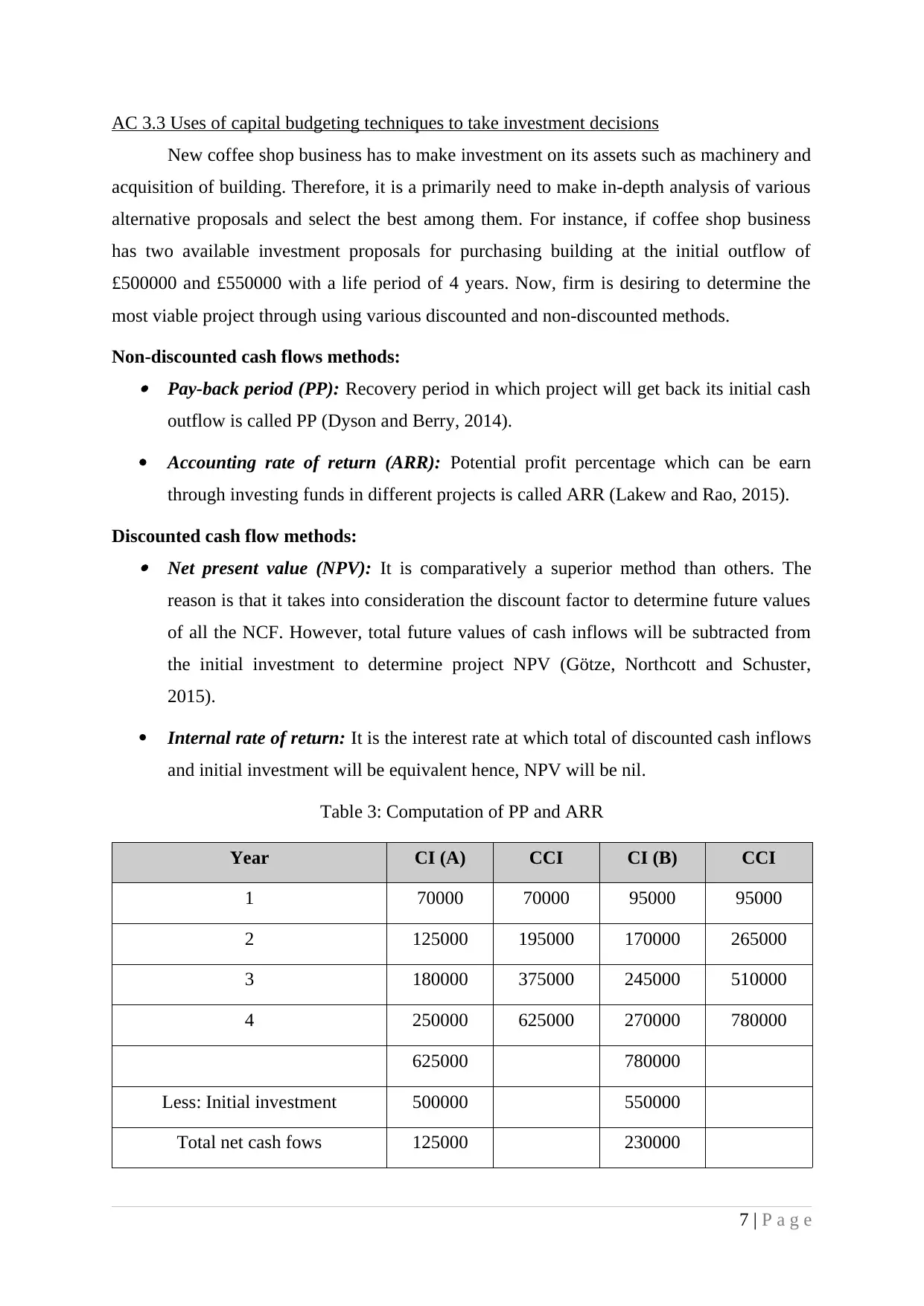
New coffee shop business has to make investment on its assets such as machinery and
acquisition of building. Therefore, it is a primarily need to make in-depth analysis of various
alternative proposals and select the best among them. For instance, if coffee shop business
has two available investment proposals for purchasing building at the initial outflow of
£500000 and £550000 with a life period of 4 years. Now, firm is desiring to determine the
most viable project through using various discounted and non-discounted methods.
Non-discounted cash flows methods: Pay-back period (PP): Recovery period in which project will get back its initial cash
outflow is called PP (Dyson and Berry, 2014).
Accounting rate of return (ARR): Potential profit percentage which can be earn
through investing funds in different projects is called ARR (Lakew and Rao, 2015).
Discounted cash flow methods: Net present value (NPV): It is comparatively a superior method than others. The
reason is that it takes into consideration the discount factor to determine future values
of all the NCF. However, total future values of cash inflows will be subtracted from
the initial investment to determine project NPV (Götze, Northcott and Schuster,
2015).
Internal rate of return: It is the interest rate at which total of discounted cash inflows
and initial investment will be equivalent hence, NPV will be nil.
Table 3: Computation of PP and ARR
Year CI (A) CCI CI (B) CCI
1 70000 70000 95000 95000
2 125000 195000 170000 265000
3 180000 375000 245000 510000
4 250000 625000 270000 780000
625000 780000
Less: Initial investment 500000 550000
Total net cash fows 125000 230000
7 | P a g e
Paraphrase This Document

(B) = 2 yr + (£500000- £265000)/( £245000) = 2.96 yr
ARR (A) = (£125000)/( £500000)*100 = 25%
(B) = (£230000)/(£550000)*100 = 41.82%
Table 4: Computation of NPV and IRR
Year CI (A)
DF @
10% DCF CI (B) DCF
1 70000 0.909 63630 95000 86355
2 125000 0.826 103250 170000 140420
3 180000 0.751 135180 245000 183995
4 250000 0.683 170750 270000 184410
Total discounted cash inflows 472810 595180
Less: Inital investment 500000 550000
NPV/IRR 7.90% -27190 13.19% 45180
Interpretation: Payback period indicates that project B will get back earlier its initial
investment within 2.96 yr. ARR represents that project B will generate high profit percentage
on invested funds. Further, as per the DCF methods, NPV of project B is positive that is
£45180 and IRR is comparatively higher than project A that is 13.19%. Thus, it has become
clear that all the techniques are concluded that coffee shop owner has to invest funds in
project B because it will provide higher business yield.
TASK 4
AC 4.1 Important financial statements
Each and every SME needs to prepare necessary financial statement under the
financial accounting procedure. It is the process of recording all the business operational and
financial transactions in an appropriate manner. Coffee shop accountant has to construct
profit and loss, balance sheet and cash flow statement as per the necessary requirements.
Profitability statement: It maintains detailed records of all the incomes and
expenditures. Its purpose is to identify business performance in the way of profits as well as
8 | P a g e
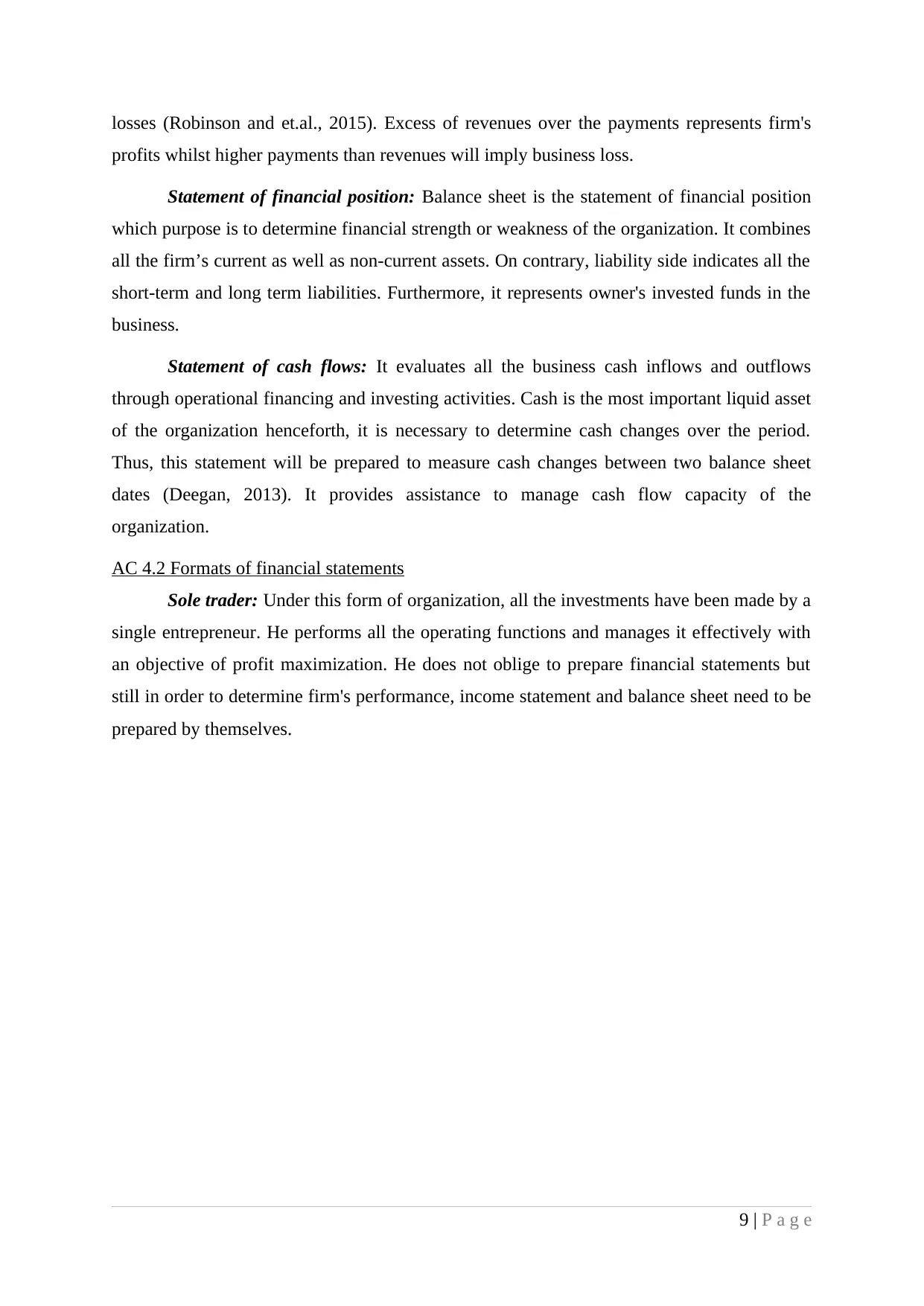
profits whilst higher payments than revenues will imply business loss.
Statement of financial position: Balance sheet is the statement of financial position
which purpose is to determine financial strength or weakness of the organization. It combines
all the firm’s current as well as non-current assets. On contrary, liability side indicates all the
short-term and long term liabilities. Furthermore, it represents owner's invested funds in the
business.
Statement of cash flows: It evaluates all the business cash inflows and outflows
through operational financing and investing activities. Cash is the most important liquid asset
of the organization henceforth, it is necessary to determine cash changes over the period.
Thus, this statement will be prepared to measure cash changes between two balance sheet
dates (Deegan, 2013). It provides assistance to manage cash flow capacity of the
organization.
AC 4.2 Formats of financial statements
Sole trader: Under this form of organization, all the investments have been made by a
single entrepreneur. He performs all the operating functions and manages it effectively with
an objective of profit maximization. He does not oblige to prepare financial statements but
still in order to determine firm's performance, income statement and balance sheet need to be
prepared by themselves.
9 | P a g e
⊘ This is a preview!⊘
Do you want full access?
Subscribe today to unlock all pages.

Trusted by 1+ million students worldwide
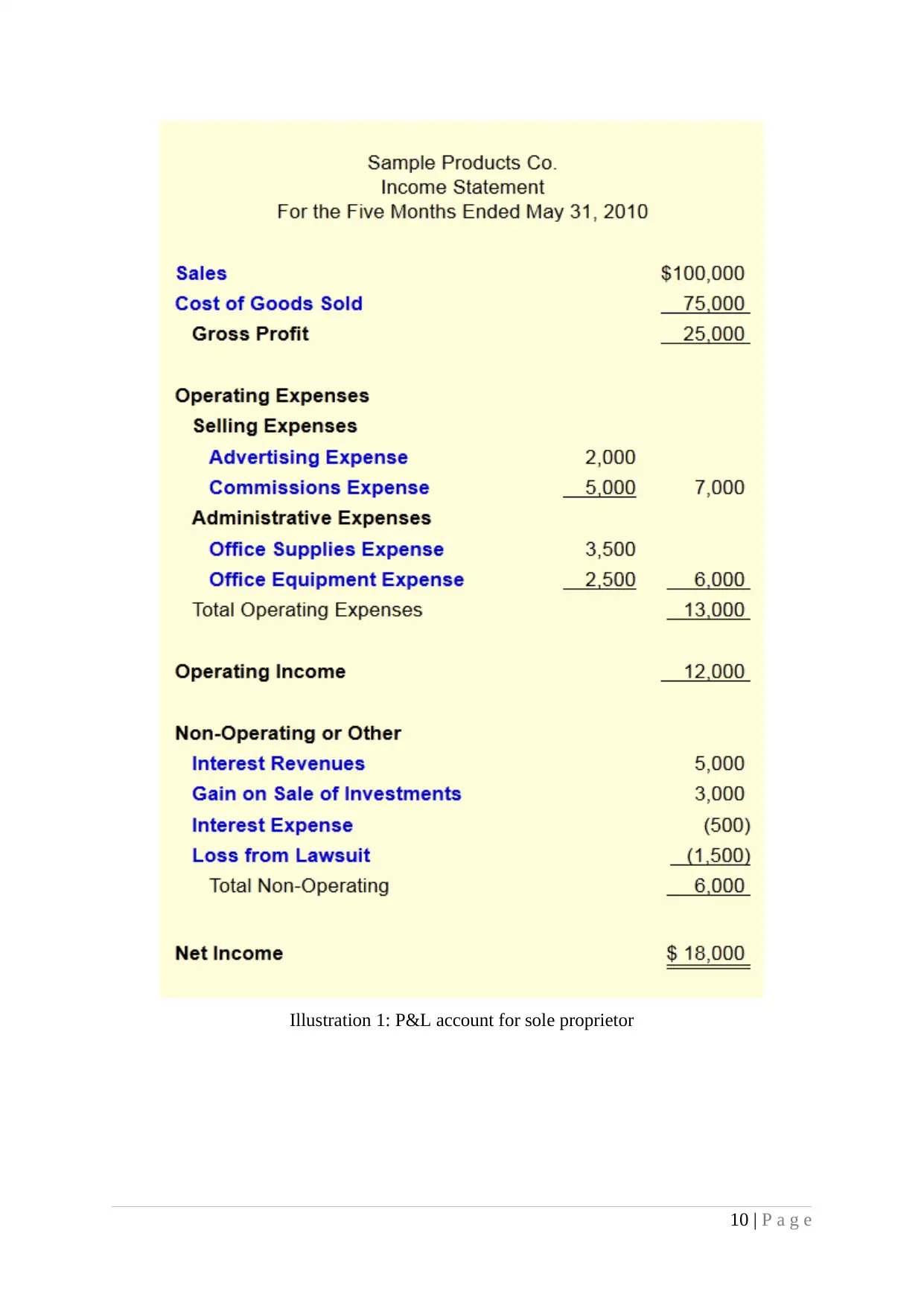
Illustration 1: P&L account for sole proprietor
Paraphrase This Document
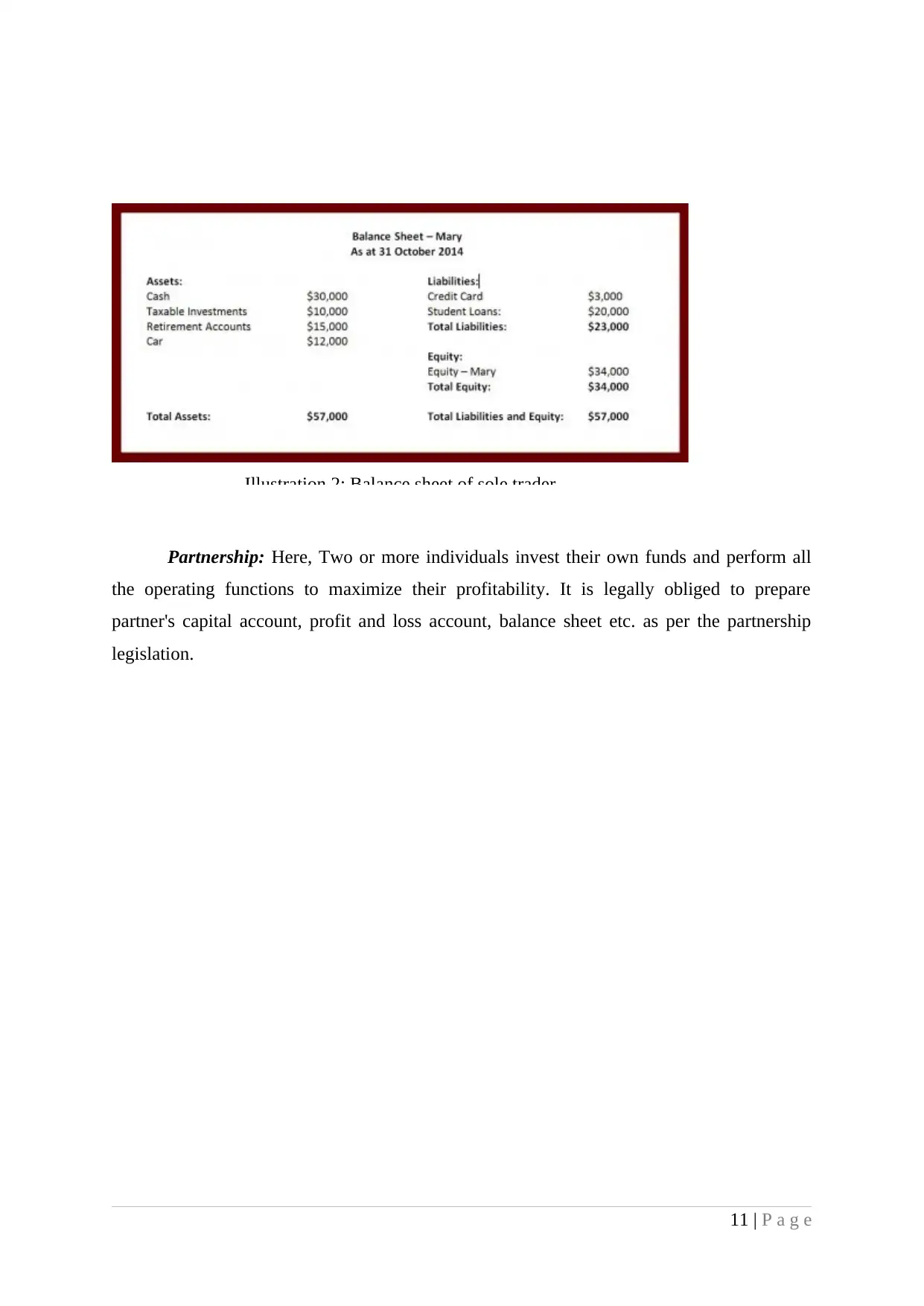
Partnership: Here, Two or more individuals invest their own funds and perform all
the operating functions to maximize their profitability. It is legally obliged to prepare
partner's capital account, profit and loss account, balance sheet etc. as per the partnership
legislation.
11 | P a g e
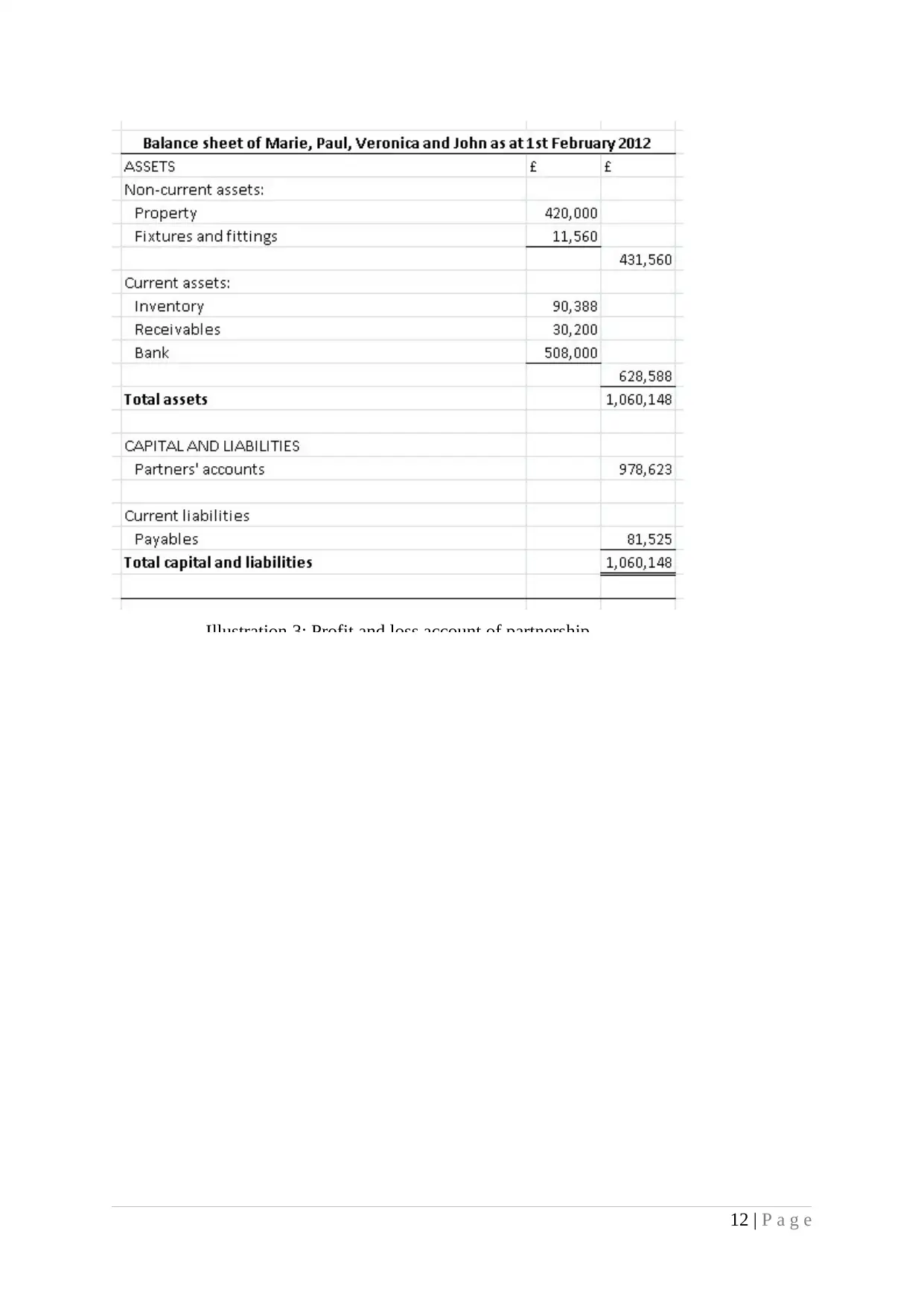
12 | P a g e
⊘ This is a preview!⊘
Do you want full access?
Subscribe today to unlock all pages.

Trusted by 1+ million students worldwide
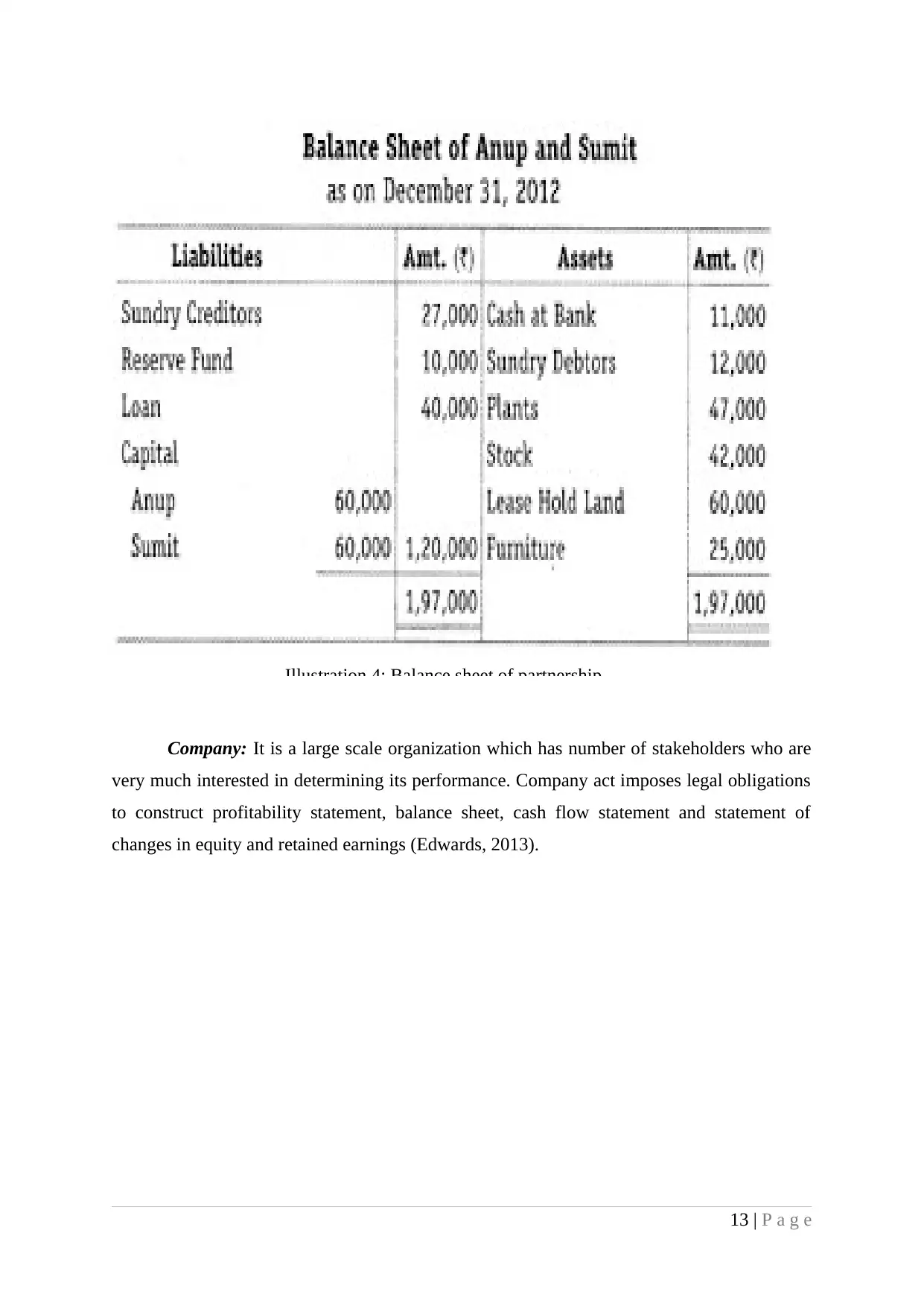
Company: It is a large scale organization which has number of stakeholders who are
very much interested in determining its performance. Company act imposes legal obligations
to construct profitability statement, balance sheet, cash flow statement and statement of
changes in equity and retained earnings (Edwards, 2013).
13 | P a g e
Paraphrase This Document
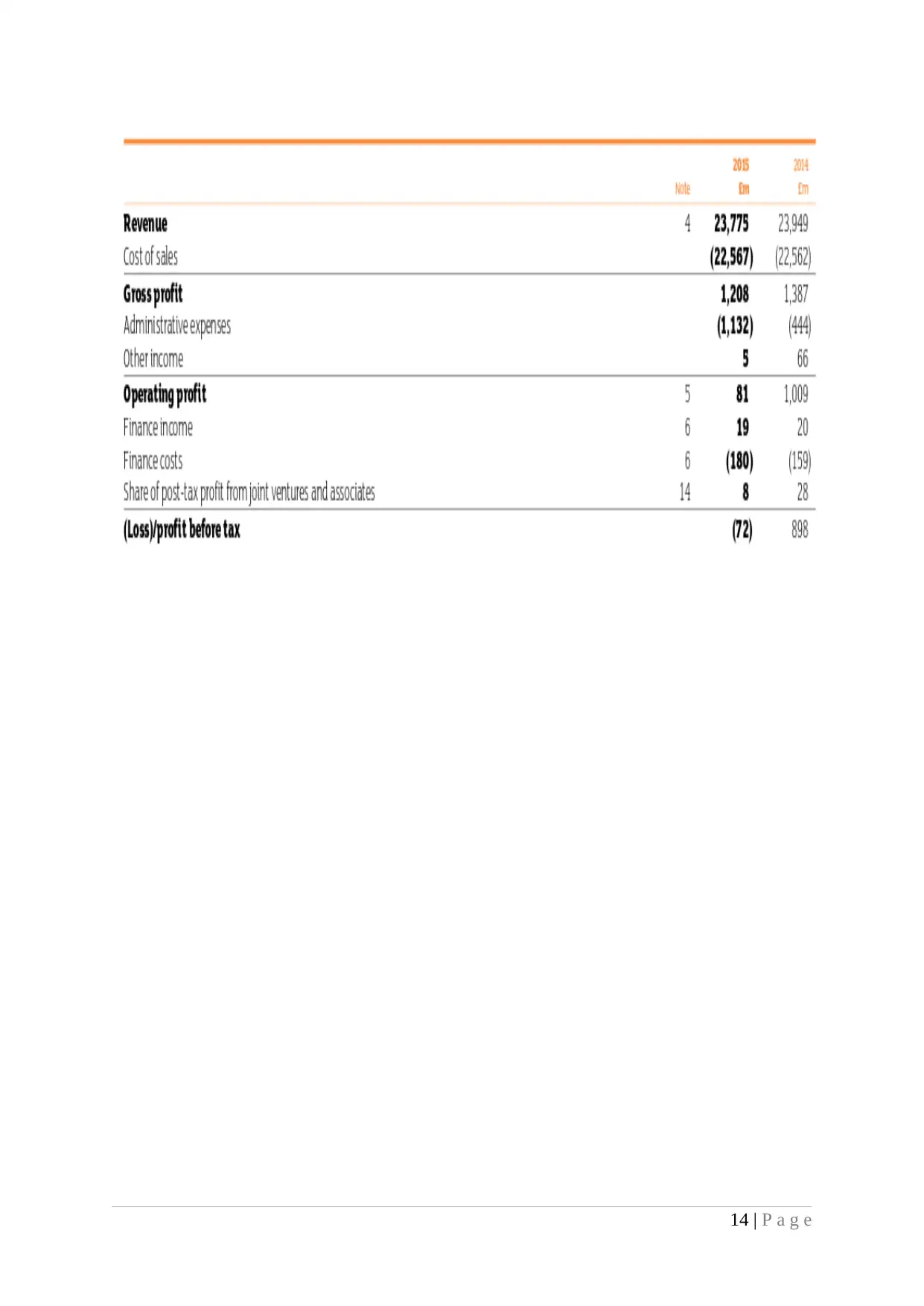

From the above structure, it has become clear that profitability statement shows all the
expenses on debit side while incomes will be shown on the credit side. For instance, sales and
interest will be organization’s incomes and purchase, custom duty, excise duty, salary, rent
and rates, advertisement, depreciation and insurance will be business expenditures. However,
in balance sheet, fixed assets include property, equipment, land, furniture etc. and current
assets include debtors, cash, inventories etc. On the other hand, equity comprises of owner's
capital contribution, reserve and surplus etc. However, bank overdraft and creditors are short-
term business obligations while debt funds are long term liabilities.
15 | P a g e
⊘ This is a preview!⊘
Do you want full access?
Subscribe today to unlock all pages.

Trusted by 1+ million students worldwide

Profitability ratios indicate that Sainsbury's performance have been declining over the
period. It is because in 2015, its GM and NM have been reduced to 5.08% and -0.70%.
Declined revenues, high purchase cost and high operating expenditures are the reasons for it.
On contrary, liquidity position has been maintained by the firm because CR remains
unchanged from 0.64 and QR shows a little bit decrease by 0.01 only. Thus, it can be
interpreted that Sainsbury managers have to improve their liquidity position so that firm will
be able to pay off their short-term liabilities effectively. Further, total assets turnover ratio
and inventory turnover ratio have been reduced to 1.44 times and 22.54 times (Sainsbury's
Annual report, 2015). It implies that firm's assets using ability has been reduced hence,
management has to frame policies to improve business efficiency. Furthermore, D/E ratio has
been risen to 0.45 which is imposing greater risk. On the other hand, idle ratio is 0.5:1 thus, it
can be said that Sainsbury is trying to maintain their solvency position to discharge their
long-term obligations effectively. Thus, it can be suggested that by maximizing sales revenue
and controlling cost, Sainsbury can greatly enhance its market performance.
CONCLUSION
Presented project report has been concluded that strategic financial planning makes
firms able to acquire appropriate collection and efficient management of funds. Furthermore,
the report has also been concluded that budgetary tools provide great assistance to ensure
optimum utilization of business resources. However, qualified investment decisions can be
taken through using investment appraisal techniques. In addition to it, ratio analysis is the
best way to analyse company's performance.
16 | P a g e
Paraphrase This Document
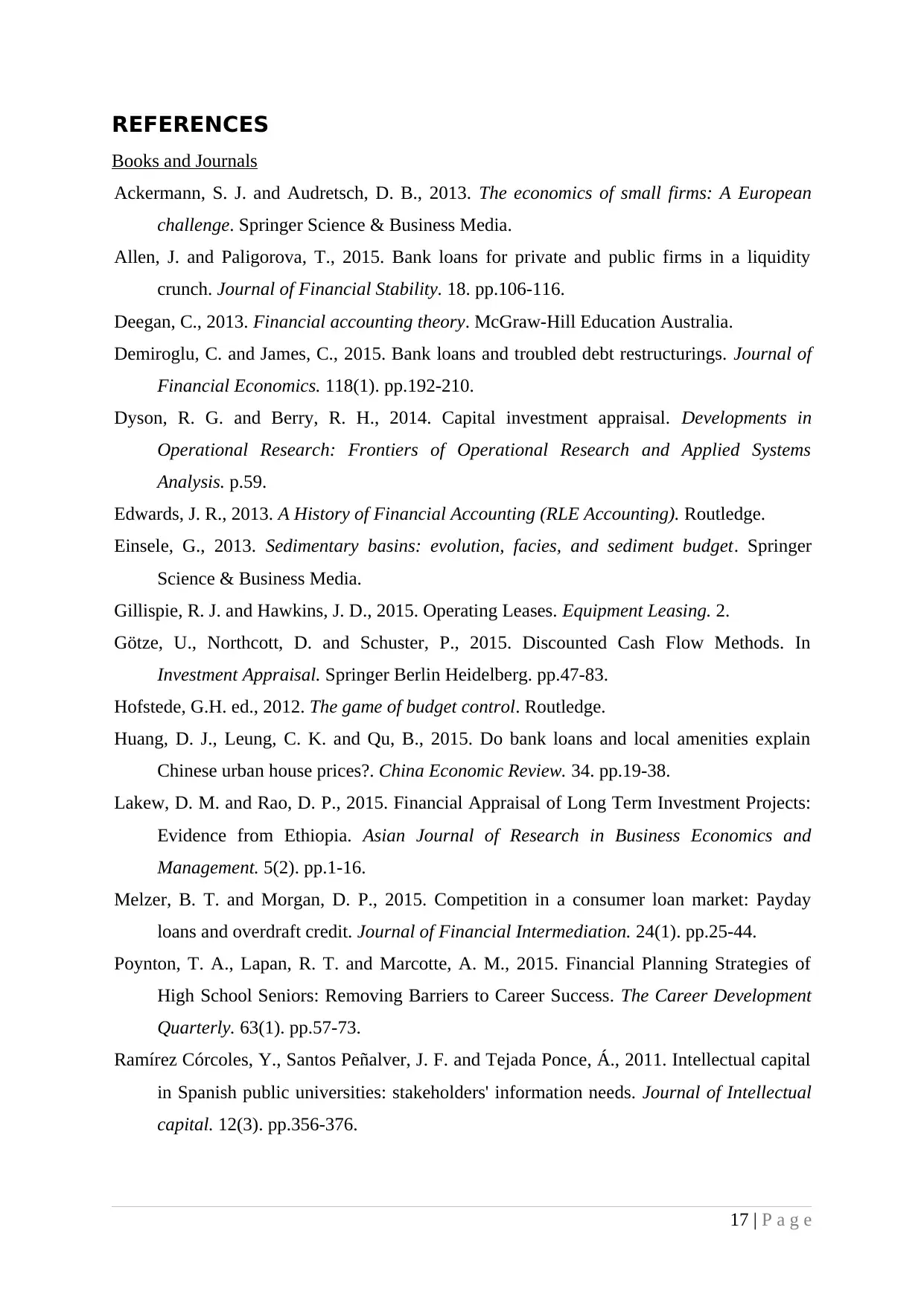
Books and Journals
Ackermann, S. J. and Audretsch, D. B., 2013. The economics of small firms: A European
challenge. Springer Science & Business Media.
Allen, J. and Paligorova, T., 2015. Bank loans for private and public firms in a liquidity
crunch. Journal of Financial Stability. 18. pp.106-116.
Deegan, C., 2013. Financial accounting theory. McGraw-Hill Education Australia.
Demiroglu, C. and James, C., 2015. Bank loans and troubled debt restructurings. Journal of
Financial Economics. 118(1). pp.192-210.
Dyson, R. G. and Berry, R. H., 2014. Capital investment appraisal. Developments in
Operational Research: Frontiers of Operational Research and Applied Systems
Analysis. p.59.
Edwards, J. R., 2013. A History of Financial Accounting (RLE Accounting). Routledge.
Einsele, G., 2013. Sedimentary basins: evolution, facies, and sediment budget. Springer
Science & Business Media.
Gillispie, R. J. and Hawkins, J. D., 2015. Operating Leases. Equipment Leasing. 2.
Götze, U., Northcott, D. and Schuster, P., 2015. Discounted Cash Flow Methods. In
Investment Appraisal. Springer Berlin Heidelberg. pp.47-83.
Hofstede, G.H. ed., 2012. The game of budget control. Routledge.
Huang, D. J., Leung, C. K. and Qu, B., 2015. Do bank loans and local amenities explain
Chinese urban house prices?. China Economic Review. 34. pp.19-38.
Lakew, D. M. and Rao, D. P., 2015. Financial Appraisal of Long Term Investment Projects:
Evidence from Ethiopia. Asian Journal of Research in Business Economics and
Management. 5(2). pp.1-16.
Melzer, B. T. and Morgan, D. P., 2015. Competition in a consumer loan market: Payday
loans and overdraft credit. Journal of Financial Intermediation. 24(1). pp.25-44.
Poynton, T. A., Lapan, R. T. and Marcotte, A. M., 2015. Financial Planning Strategies of
High School Seniors: Removing Barriers to Career Success. The Career Development
Quarterly. 63(1). pp.57-73.
Ramírez Córcoles, Y., Santos Peñalver, J. F. and Tejada Ponce, Á., 2011. Intellectual capital
in Spanish public universities: stakeholders' information needs. Journal of Intellectual
capital. 12(3). pp.356-376.
17 | P a g e
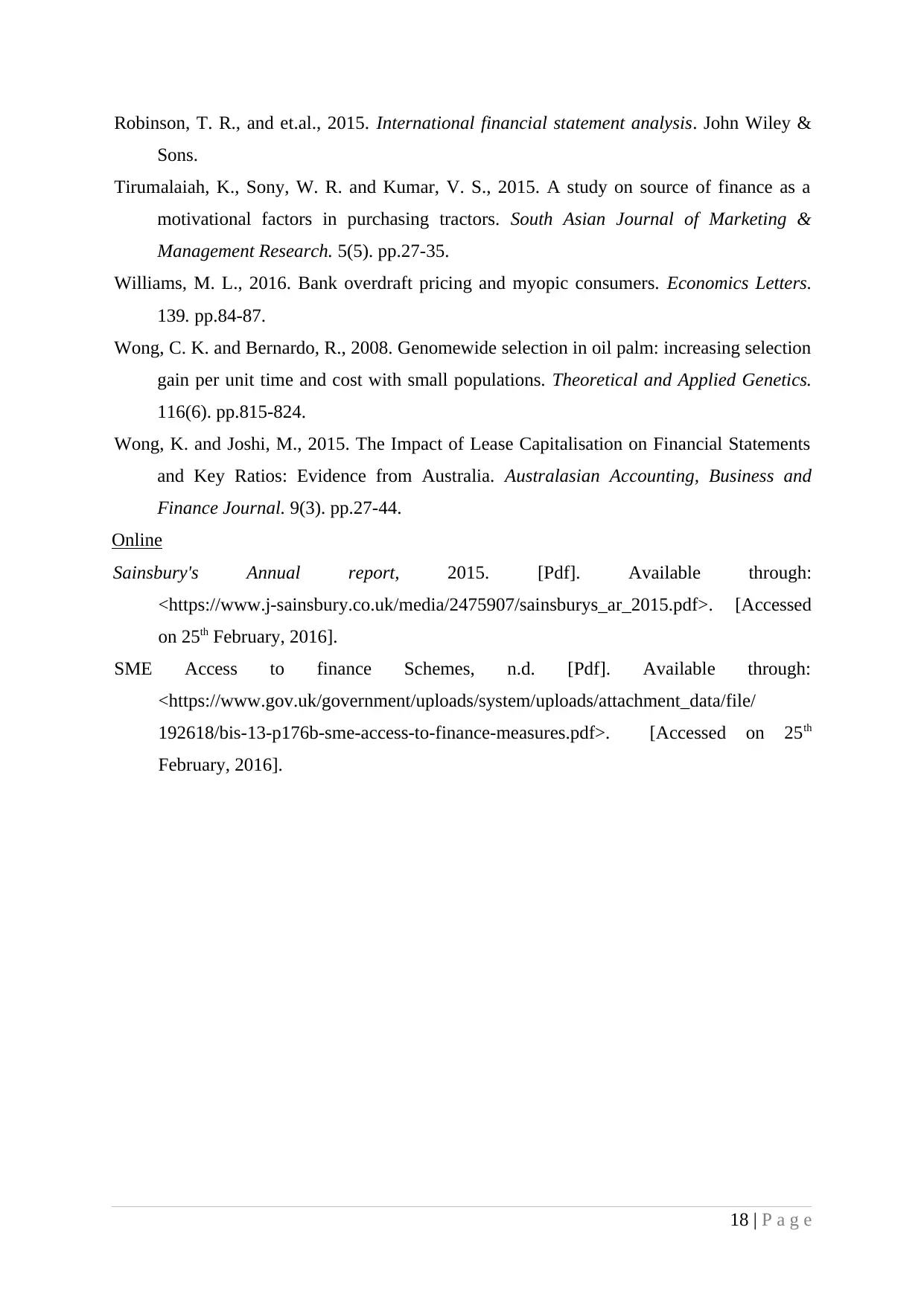
Sons.
Tirumalaiah, K., Sony, W. R. and Kumar, V. S., 2015. A study on source of finance as a
motivational factors in purchasing tractors. South Asian Journal of Marketing &
Management Research. 5(5). pp.27-35.
Williams, M. L., 2016. Bank overdraft pricing and myopic consumers. Economics Letters.
139. pp.84-87.
Wong, C. K. and Bernardo, R., 2008. Genomewide selection in oil palm: increasing selection
gain per unit time and cost with small populations. Theoretical and Applied Genetics.
116(6). pp.815-824.
Wong, K. and Joshi, M., 2015. The Impact of Lease Capitalisation on Financial Statements
and Key Ratios: Evidence from Australia. Australasian Accounting, Business and
Finance Journal. 9(3). pp.27-44.
Online
Sainsbury's Annual report, 2015. [Pdf]. Available through:
<https://www.j-sainsbury.co.uk/media/2475907/sainsburys_ar_2015.pdf>. [Accessed
on 25th February, 2016].
SME Access to finance Schemes, n.d. [Pdf]. Available through:
<https://www.gov.uk/government/uploads/system/uploads/attachment_data/file/
192618/bis-13-p176b-sme-access-to-finance-measures.pdf>. [Accessed on 25th
February, 2016].
18 | P a g e
⊘ This is a preview!⊘
Do you want full access?
Subscribe today to unlock all pages.

Trusted by 1+ million students worldwide
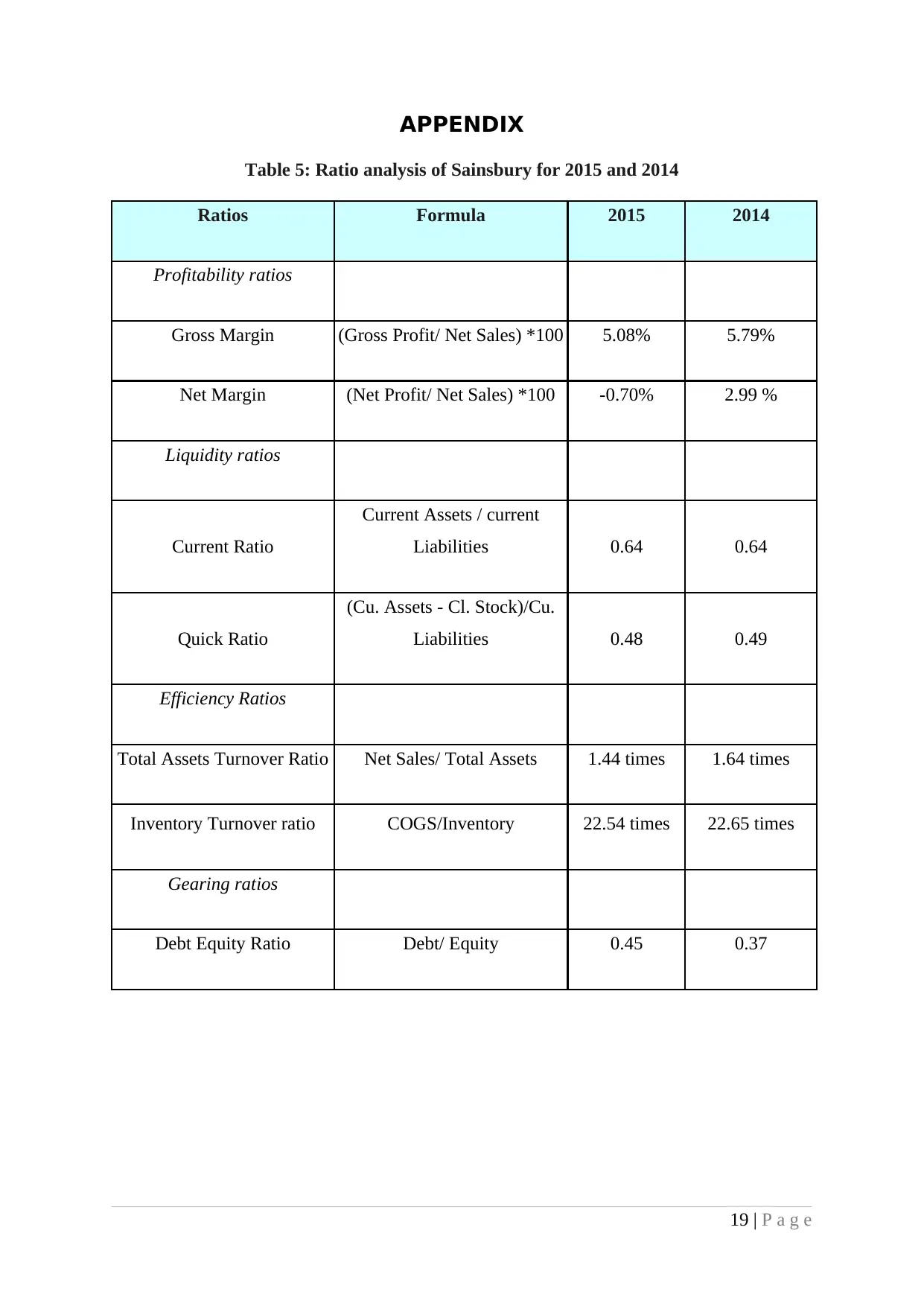
Table 5: Ratio analysis of Sainsbury for 2015 and 2014
Ratios Formula 2015 2014
Profitability ratios
Gross Margin (Gross Profit/ Net Sales) *100 5.08% 5.79%
Net Margin (Net Profit/ Net Sales) *100 -0.70% 2.99 %
Liquidity ratios
Current Ratio
Current Assets / current
Liabilities 0.64 0.64
Quick Ratio
(Cu. Assets - Cl. Stock)/Cu.
Liabilities 0.48 0.49
Efficiency Ratios
Total Assets Turnover Ratio Net Sales/ Total Assets 1.44 times 1.64 times
Inventory Turnover ratio COGS/Inventory 22.54 times 22.65 times
Gearing ratios
Debt Equity Ratio Debt/ Equity 0.45 0.37
19 | P a g e
Paraphrase This Document

Related Documents
Your All-in-One AI-Powered Toolkit for Academic Success.
+13062052269
info@desklib.com
Available 24*7 on WhatsApp / Email
![[object Object]](/_next/static/media/star-bottom.7253800d.svg)
© 2024 | Zucol Services PVT LTD | All rights reserved.





